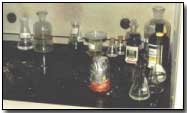Encyclopedia - Lyddite
 Lyddite was a form of high
explosive widely used during both the Boer War and First World War, most
notably during the latter by the British. Named after the area in
southern England in which the substance's initial trials were performed so
as to maintain secrecy, Lyddite was actually composed of molten and cast
picric acid.
Lyddite was a form of high
explosive widely used during both the Boer War and First World War, most
notably during the latter by the British. Named after the area in
southern England in which the substance's initial trials were performed so
as to maintain secrecy, Lyddite was actually composed of molten and cast
picric acid.
First tested in 1888 Lyddite was considered a relatively 'insensitive' explosive, which meant that it lent itself moderately well to armour piercing shells, given that the substance was less liable to detonate immediately upon impact but would instead be triggered by an impact fuse. In practice however Lyddite shells would detonate while in the process of tearing through armour.
The U.S. high explosive Dunnite, while less powerful than Lyddite, was widely used by U.S. forces on the basis that it was considered even less sensitive than Lyddite and thus less likely to detonate immediately upon impact.
A Town Major was a staff officer responsible for billeting arrangements in a town or village behind the lines.
- Did you know?
